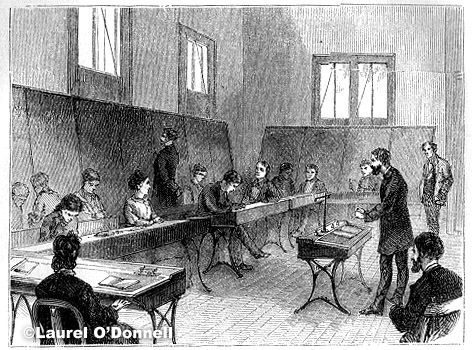|
|
Ten Days With the Deaf and Dumb, continued

The Graduating Class
One of the exercises in the supplemental class that day was a recitation in Caesar. The teacher — Professor Jenkins — assigned a portion of the text to each pupil, and correct translations were promptly written. Afterward a few English sentences were given them, which they rendered into Latin. Having once learned English, it is said that deaf-mutes find no especial difficulty in other languages. Indeed, one would fancy that French or Latin might be easier for them than, English, since the arrangement of words in the former corresponds better to the order followed in the sign language. At another time I was present when Professor Cooke gave the supplemental class an unexpected examination in the elements of moral science, which they had pursued several months before. Definitions of law, moral law, conscience, and the like, were promptly given, and practical questions answered by the class, in a manner that showed a good understanding of the subject. In the high class proper I also witnessed commendable recitations in algebra and various other studies. By this time, having seen so much achieved in the education of the deaf and dumb, I was full of curiosity to know how they begin it. Accordingly, my friend took me to a school-room where were the youngest and most backward of all. My wish having been mentioned, the gentlemanly teacher-himself a mute-beckoned to his side a little dumb child, who had but just entered school. Very kindly and patiently he taught her a single word to her the beginning of all that language has to reveal. I gazed with a feeling akin to awe. It is but a slender thread that he has thrown across the dark gulf beyond which, helpless and alone, lies the imprisoned soul. But, little by little, be will bridge the chasm, and blessings will go and come for evermore. It seems a trifle to learn one word, but it involves a good deal. There are three steps in the process. The word being, for example, "pen," a picture of the object, or the pen itself, is exhibited, and the sign for it is made, which consists in moving the fingers of the right hand over the palm of the left, as if writing. Next, the word "pen" is spelled by the fingers, and the little pupil learns to do the same. Finally, the teacher, taking a crayon, writes the word upon the wall-slate, and shows the child how to copy that also. Great care is constantly taken to associate the object with its sign or name, and many repetitions are needful in order to fix the lesson in the undisciplined memory. Not until the child can make the sign at sight of the object or its picture, can spell its name with the fingers, and write it upon the slate, is the word considered to have been learned. Page 11
These pages are © Laurel O’Donnell, 2006, all rights reserved Copying these pages without written permission for the purpose of republishing in print or electronic format is strictly forbidden. Books & articles appearing here are modified adaptations. This page was last updated on 01 Jul 2006 |
